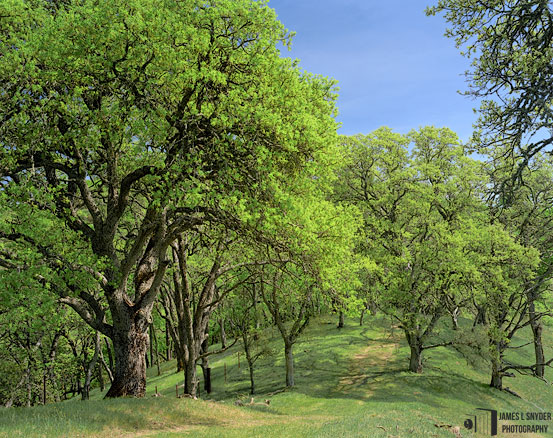

Joseph D. Grant County Park, Santa Clara County, CA, 3/30/2007
On a cool clear day in early spring, a friend and I decided to hike the entire length of Washburn Trail in Joseph Grant County Park near San Jose, CA. We explored this area at the extreme north end of the park for the first time and enjoyed the beautiful green springtime vistas we found along the way! Early spring is a good season to admire the grass covered hills of the Diablo Range; later each year all the grass turns brown, completely transforming the scenery. Beginning in Halls Valley, we hiked up into the foothills through grassland and patches of oak woodland. Reaching a hilltop at 2,240 feet above sea level, the trail turned eastward revealing this delightful scene I instantly knew should be photographed. The arrangement of the trees, the freshness and purity of the greens, and the beckoning quality of the trail all joined together to personify the beautiful springtime feeling of our adventure that day. Here we look east southeast along the trail, which follows a ridge forming the south edge of a blue oak woods. At left is an oak forest canyon, and grass covered hills descend into Halls Valley to the right. In 1831 the famous Scottish explorer and botanist David Douglas (1798-1834) named this deciduous tree blue oak (Quercus douglasii). The name refers to the bluish color caused by the waxy coating on its leaves, which also helps the tree conserve water. The leaves are usually one to three inches long with wavy margins and appear bluish-green by late summer (not early spring). The blue oak is native to California and grows in the valleys and lower slopes here in the coast mountain ranges, the lower western foothills of the Sierra Nevada, and the north slopes of the San Gabriel Mountains. Blue oaks are adapted to drought and dry climates and can survive temperatures above 100° F for several weeks at a time. Covering about three million acres, blue oak is one of the largest ancient forest types in California. As we see here, at lower elevations it merges with annual grasslands while at higher elevations it blends with chaparral, pinyon, and juniper woodlands. Blue oaks have been extensively utilized by native cultures. Local native Americans ate a meal made from the acorns, previously steeped in water to remove bitterness. They used the liquid from processing the fruit for dyeing their baskets black, and they made bowls from the tree’s wood. Other uses include utensils, toys, and construction materials. The inner bark was boiled and the brew provided relief of arthritis. Acorns also served as bait in bird traps by the Gabrielino, Sierra Miwok, and other tribes.